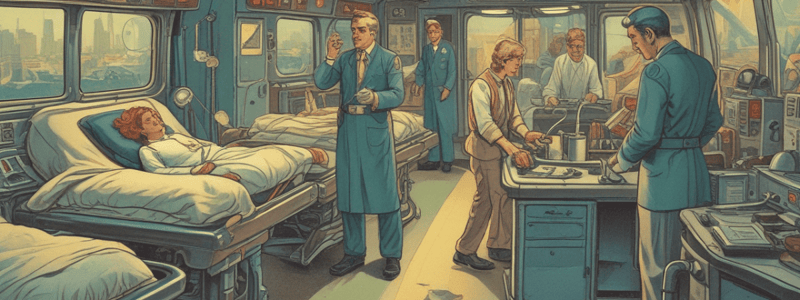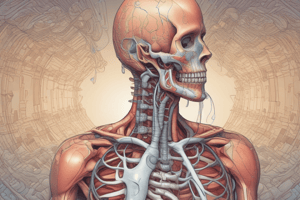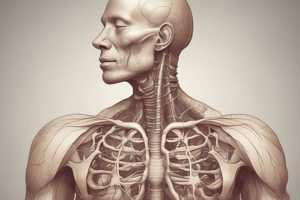Podcast
Questions and Answers
What is the primary function of positive end-expiratory pressure (PEEP)?
What is the primary function of positive end-expiratory pressure (PEEP)?
- To increase the volume of dead space in the respiratory system
- To increase intrathoracic pressure and improve gas exchange
- To prevent end-expiratory collapse of the small airways and alveoli (correct)
- To decrease the work of breathing during exhalation
What is the typical range of anatomical PEEP in healthy individuals?
What is the typical range of anatomical PEEP in healthy individuals?
- 3-5 cmH2O (correct)
- 5-7 cmH2O
- 1-3 cmH2O
- 7-9 cmH2O
What is the primary mechanism by which inhalation occurs during natural inspiration?
What is the primary mechanism by which inhalation occurs during natural inspiration?
- Passive elastic recoil of the lungs
- Active contraction of the intercostal muscles
- Positive pressure ventilation pushing air into the lungs
- Negative pressure ventilation sucking air into the lungs (correct)
What is the primary function of exhalation during normal breathing?
What is the primary function of exhalation during normal breathing?
What is the primary purpose of PEEP in patients with acute respiratory distress syndrome (ARDS)?
What is the primary purpose of PEEP in patients with acute respiratory distress syndrome (ARDS)?
What is the primary complication associated with the use of high levels of PEEP?
What is the primary complication associated with the use of high levels of PEEP?
What is the primary purpose of CPAP (continuous positive airway pressure) ventilation?
What is the primary purpose of CPAP (continuous positive airway pressure) ventilation?
What is the approximate percentage of each breath that is comprised of dead space in a healthy individual?
What is the approximate percentage of each breath that is comprised of dead space in a healthy individual?
What is the primary mechanism by which PEEP improves gas exchange in patients with acute respiratory distress syndrome (ARDS)?
What is the primary mechanism by which PEEP improves gas exchange in patients with acute respiratory distress syndrome (ARDS)?
What is the primary difference between natural inspiration and positive pressure ventilation in terms of the mechanics of air movement?
What is the primary difference between natural inspiration and positive pressure ventilation in terms of the mechanics of air movement?
What is the primary mechanism by which carbon dioxide (CO2) is eliminated from the body during respiration?
What is the primary mechanism by which carbon dioxide (CO2) is eliminated from the body during respiration?
What is the primary consequence of a complete cessation of ventilation?
What is the primary consequence of a complete cessation of ventilation?
Which of the following conditions is primarily responsible for the mismatch between arterial and end-tidal carbon dioxide levels (PaCO2 and ETCO2)?
Which of the following conditions is primarily responsible for the mismatch between arterial and end-tidal carbon dioxide levels (PaCO2 and ETCO2)?
What is the primary stimulus for breathing in normal physiology?
What is the primary stimulus for breathing in normal physiology?
What is the primary benefit of pre-oxygenation and passive oxygenation in patients with respiratory distress?
What is the primary benefit of pre-oxygenation and passive oxygenation in patients with respiratory distress?
What is the primary consequence of excessive ventilation in a patient with normal lung function?
What is the primary consequence of excessive ventilation in a patient with normal lung function?
What is the primary factor that determines the efficiency of ventilation in patients with lung disease?
What is the primary factor that determines the efficiency of ventilation in patients with lung disease?
What is the primary mechanism by which positive end-expiratory pressure (PEEP) improves gas exchange in patients with acute respiratory distress syndrome (ARDS)?
What is the primary mechanism by which positive end-expiratory pressure (PEEP) improves gas exchange in patients with acute respiratory distress syndrome (ARDS)?
What is the primary consequence of an increase in the arterial partial pressure of carbon dioxide (PaCO2) in patients with chronic obstructive pulmonary disease (COPD)?
What is the primary consequence of an increase in the arterial partial pressure of carbon dioxide (PaCO2) in patients with chronic obstructive pulmonary disease (COPD)?
What is the primary mechanism by which the body maintains the partial pressure gradient for carbon dioxide (CO2) elimination during respiration?
What is the primary mechanism by which the body maintains the partial pressure gradient for carbon dioxide (CO2) elimination during respiration?
What is the best way to manage BVM ventilations according to the text?
What is the best way to manage BVM ventilations according to the text?
What is the optimal position for intubating non-traumatic adult patients?
What is the optimal position for intubating non-traumatic adult patients?
Which position is recommended for children and pediatric patients during intubation?
Which position is recommended for children and pediatric patients during intubation?
What should be avoided when managing an airway using a BVM?
What should be avoided when managing an airway using a BVM?
What is the traditional method of utilizing the BVM?
What is the traditional method of utilizing the BVM?
What can optimize patient oxygenation prior to intubation?
What can optimize patient oxygenation prior to intubation?
What is the primary purpose of the 'Jaw Thrust' technique in airway management?
What is the primary purpose of the 'Jaw Thrust' technique in airway management?
What is the significance of the '4-90's' mentioned in the text?
What is the significance of the '4-90's' mentioned in the text?
What is the primary purpose of the 'Mallampati' assessment mentioned in the text?
What is the primary purpose of the 'Mallampati' assessment mentioned in the text?
What is the primary purpose of the 'Scissor Technique' in airway management?
What is the primary purpose of the 'Scissor Technique' in airway management?
What is the primary goal of the 'System One Training' mentioned in the text?
What is the primary goal of the 'System One Training' mentioned in the text?
What is the significance of the '3:3:2' rule in airway assessment?
What is the significance of the '3:3:2' rule in airway assessment?
What is the primary purpose of the 'Head Tilt' technique mentioned in the text?
What is the primary purpose of the 'Head Tilt' technique mentioned in the text?
What is the significance of the term 'Airway is a team sport' mentioned in the text?
What is the significance of the term 'Airway is a team sport' mentioned in the text?
What is the primary indication for using a bougie during a difficult adult intubation?
What is the primary indication for using a bougie during a difficult adult intubation?
Which of the following is NOT a primary function of positive end-expiratory pressure (PEEP) in patients with acute respiratory distress syndrome (ARDS)?
Which of the following is NOT a primary function of positive end-expiratory pressure (PEEP) in patients with acute respiratory distress syndrome (ARDS)?
What is the primary purpose of the tongue traction technique described in the text?
What is the primary purpose of the tongue traction technique described in the text?
Which of the following is the primary mechanism by which positive end-expiratory pressure (PEEP) improves gas exchange in patients with acute respiratory distress syndrome (ARDS)?
Which of the following is the primary mechanism by which positive end-expiratory pressure (PEEP) improves gas exchange in patients with acute respiratory distress syndrome (ARDS)?
What is the primary purpose of the 'C-DOPE' mnemonic when questioning endotracheal tube (ETT) placement?
What is the primary purpose of the 'C-DOPE' mnemonic when questioning endotracheal tube (ETT) placement?
What is the primary consequence of a complete cessation of ventilation in a healthy individual?
What is the primary consequence of a complete cessation of ventilation in a healthy individual?
What is the primary purpose of the 'Modified Cormack & Lehane Classification' mentioned in the text?
What is the primary purpose of the 'Modified Cormack & Lehane Classification' mentioned in the text?
What is the primary stimulus for breathing in normal physiology?
What is the primary stimulus for breathing in normal physiology?
What is the primary purpose of the 'King Airway' device?
What is the primary purpose of the 'King Airway' device?
What is the primary function of exhalation during normal breathing?
What is the primary function of exhalation during normal breathing?
What is the primary mechanism by which positive end-expiratory pressure (PEEP) improves gas exchange in patients with acute respiratory distress syndrome (ARDS)?
What is the primary mechanism by which positive end-expiratory pressure (PEEP) improves gas exchange in patients with acute respiratory distress syndrome (ARDS)?
What is the primary mechanism by which the body maintains the partial pressure gradient for carbon dioxide (CO2) elimination during respiration?
What is the primary mechanism by which the body maintains the partial pressure gradient for carbon dioxide (CO2) elimination during respiration?
What is the primary consequence of an increase in the arterial partial pressure of carbon dioxide (PaCO2) in patients with chronic obstructive pulmonary disease (COPD)?
What is the primary consequence of an increase in the arterial partial pressure of carbon dioxide (PaCO2) in patients with chronic obstructive pulmonary disease (COPD)?
What is the primary purpose of the 'System One Training' mentioned in the text?
What is the primary purpose of the 'System One Training' mentioned in the text?
Which of the following is the primary mechanism by which carbon dioxide (CO2) is eliminated from the body during respiration?
Which of the following is the primary mechanism by which carbon dioxide (CO2) is eliminated from the body during respiration?
Which of the following conditions is primarily responsible for the mismatch between arterial and end-tidal carbon dioxide levels (PaCO2 and ETCO2)?
Which of the following conditions is primarily responsible for the mismatch between arterial and end-tidal carbon dioxide levels (PaCO2 and ETCO2)?
What is the primary stimulus for breathing in normal physiology?
What is the primary stimulus for breathing in normal physiology?
What is the primary mechanism by which positive end-expiratory pressure (PEEP) improves gas exchange in patients with acute respiratory distress syndrome (ARDS)?
What is the primary mechanism by which positive end-expiratory pressure (PEEP) improves gas exchange in patients with acute respiratory distress syndrome (ARDS)?
What is the primary difference between natural inspiration and positive pressure ventilation in terms of the mechanics of air movement?
What is the primary difference between natural inspiration and positive pressure ventilation in terms of the mechanics of air movement?
What is the primary consequence of a complete cessation of ventilation?
What is the primary consequence of a complete cessation of ventilation?
What is the primary function of exhalation during normal breathing?
What is the primary function of exhalation during normal breathing?
What is the primary mechanism by which inhalation occurs during natural inspiration?
What is the primary mechanism by which inhalation occurs during natural inspiration?
What is the primary consequence of excessive ventilation in a patient with normal lung function?
What is the primary consequence of excessive ventilation in a patient with normal lung function?
What is the primary purpose of the 'S.A.L.A.D.' technique?
What is the primary purpose of the 'S.A.L.A.D.' technique?
Which technique involves applying backward, upward, and rightward pressure to improve visualization of the larynx during intubation?
Which technique involves applying backward, upward, and rightward pressure to improve visualization of the larynx during intubation?
What is the primary purpose of using a bougie during a difficult intubation?
What is the primary purpose of using a bougie during a difficult intubation?
Which technique involves applying external pressure on the cricoid cartilage to improve visualization of the larynx?
Which technique involves applying external pressure on the cricoid cartilage to improve visualization of the larynx?
What is the purpose of using different blade grips during intubation?
What is the purpose of using different blade grips during intubation?
Which technique involves applying traction on the patient's lips to improve visualization of the larynx?
Which technique involves applying traction on the patient's lips to improve visualization of the larynx?
What is the purpose of inflating the balloon on the endotracheal tube during intubation?
What is the purpose of inflating the balloon on the endotracheal tube during intubation?
Flashcards are hidden until you start studying
Study Notes
Airway Physiology, Assessment, and Management
Upper and Lower Airways
- The upper airway begins at the nose and mouth and ends at the glottic opening
- The lower airway begins at the glottic opening and ends at the alveoli
- The trachea (windpipe) is a tube made semi-rigid by rings of cartilage, connecting the glottic opening to the carina
- The carina is a cartilaginous dividing point where the trachea splits into the two main bronchi
Trachea Internal Structure Review
- The trachea is lined by pseudostratified columnar epithelium with cilia on the surface
- The trachea is composed of 20 rings of tough cartilage, with muscle and connective tissue at the back
- Inflammation, stenosis, trauma, infection, and cancer can affect the trachea
Respiratory Volumes
- Ideal volume with each breath is roughly 6-8 mL/kg of ideal body weight (IBW)
- "Bagging" patients too hard, too fast, or with too much volume is common
- Predicted body weight (PBW) should be used instead of actual body weight, especially for obese patients
Inspiration and Expiration
- Inspiration is an active process requiring muscle contraction, resulting in negative pressure
- Exhalation is a passive process using natural elastic recoil
- Positive pressure ventilation increases intrathoracic pressure, whereas negative pressure decreases it
Positive End-Expiratory Pressure (PEEP)
- PEEP is used to prevent alveolar collapse and to recruit alveoli
- Intrinsic and extrinsic PEEP can be used, with typical pressures ranging from 3-5 cmH2O
- Complications of high PEEP include decreased cardiac output and barotrauma
Ventilation
- Ventilation is the process of mixing fresh inspired gas with alveolar gas
- Oxygenation is the process of getting oxygen to the tissues via the respiratory system
- Oxygenation begins with external respiration and involves passive diffusion across the alveolar-capillary membrane
Oxygenation Terms
- FiO2: fraction of inspired oxygen
- SaO2: percentage of hemoglobin saturated with oxygen
- SpO2: percentage of hemoglobin saturated with oxygen, measured indirectly by pulse oximetry
- PaO2: partial pressure of oxygen dissolved in plasma
- SvO2: percentage of oxygen in venous blood
Increasing Oxygenation
- Increasing oxygenation can be achieved through natural means or with supplemental oxygen
- Methods include increasing minute volume, reducing elevation, using auto-PEEP or CPAP/BiPAP, and increasing the FiO2 with supplemental oxygen
Oxygen-Hemoglobin Dissociation Curve
- The curve describes the relationship between partial pressure of oxygen and oxygen saturation
- Factors affecting the curve include body temperature, pH, and 2,3-DPG levels
- The curve shifts to the right with increased temperature, acidity, or 2,3-DPG levels
- The curve shifts to the left with decreased temperature, alkalinity, or 2,3-DPG levels
Carbon Dioxide and Capnography
-
CO2 is a byproduct of metabolism and is eliminated through the lungs during exhalation
-
End-tidal CO2 (ETCO2) is measured indirectly and is lower than arterial CO2 (PaCO2)
-
The gradient between PaCO2 and ETCO2 increases in patients with V:Q mismatch, such as those with COPD or pulmonary embolisms### Difficult Adult Intubation
-
When unable to feel the cricothyroid rings or ridges, place the bougie until it bottoms out at the carina.
-
If the bougie does not hit resistance, it may be in the stomach, not the trachea.
Tongue Traction
- Use right-hand traction to pull and push the patient's tongue anteriorly.
Modified Cormack & Lehane Classification
- Used for documentation purposes in ETT assessment.
ETT Placement Assessment
- C-DOPE:
- Assess EtCO2
- Assess for ETT dislodgement
- Assess for ETT obstruction
- Assess for pneumothorax (PTX)
- Reassess equipment.
References
- Mercy Air BLS/ALS airway education, 2016
- EMCrit.org
- Riverside University Health Systems, Anastasia Department
Studying That Suits You
Use AI to generate personalized quizzes and flashcards to suit your learning preferences.



